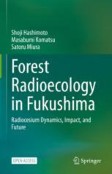Search
Search Results
-
Radioactive Materials Released by the Fukushima Nuclear Accident
In this chapter, the release of radioactive materials and the characteristics of the forest ecosystem will be described to get an overall picture of...
-
The Chernobyl Nuclear Power Plant Accident: Countermeasures and Remedial Actions in Agriculture
AbstractA wide range of countermeasures and remedial actions has been developed and used to mitigate the consequences of the Chernobyl accident. This...

-
Morphometric Indicators of Pine Needles 35 Years after the Chernobyl Accident
AbstractThirty-five years after the accident at the Chernobyl nuclear power plant, the morphometric indicators of the needles of Scots pine growing...

-
Assessing the impact of large-scale farmland abandonment on the habitat distributions of frog species after the Fukushima nuclear accident
Rice paddies function as wetlands; therefore, abandoned paddy fields cause a loss of habitats for aquatic species, such as amphibians. Following the...

-
Dynamics of 137Cs Concentration in Fodder in the Long-Term after the Chernobyl Accident
AbstractThe data on the dynamics of the 137 Cs transfer coefficients ( T f ) for fodder in the long term after the Chernobyl accident (2008–2020) are...

-
Radiocesium contaminations and transfer in cyclorrhaphous flies (Diptera: Muscidae, Calliphoridae) at three distances from the Fukushima Dai-ichi Nuclear Power Plant after the 2011 accident
Radiocesium contaminations in Diptera (Muscidae, Calliphoridae) was investigated at three distances (11 km, 14 km, and 25 km) from the Fukushima...

-
Retrospective Assessment of the Formation of the Radiation Situation in Pine Plantations in the First Year after the Chernobyl Accident
AbstractThe results of retrospective assessment of the density of radionuclide deposition as result of the Chernobyl accident for pine plantations...

-
Morphological Characteristics of Japanese Red Pine Needles from the Areas of the Fukushima NPP Accident
AbstractThe morphometric and morphological parameters of needles of Japanese red pine growing in radioactively contaminated as a result of the...

-
Risk of Radioactive Contamination Caused by the Accident of Fukushima Daiichi Nuclear Power Plant
The tsunami that occurred at the 2011 Tōhoku earthquake caused a severe accident with a hydrogen explosion at the Fukushima Daiichi Nuclear Power...
-
What Have We Learned about the Biological Effects of Radiation from the 35 Years of Analysis of the Consequences of the Chernobyl NPP Accident?
AbstractThe results of long-term studies of the radiobiological effects in plants and animals inhabiting territories contaminated as a result of the...

-
Current State of Tree Stands in the East-Ural Radioactive Trace Area Closest to Kyshtym Accident Epicenter
Abstract—The current state of forest stands has been assessed in the most polluted part of East Ural Radioactive Trace (EURT) formed as a result of...

-
The Association between Hypermethylation of Gene Promoters and Cytogenetic Disturbances in Humans Exposed to Radiation as a Result of the Chernobyl Accident
Abstract—The estimation of hypermethylation of the cell cycle ( RASSF1A, p16/INK4A, p14/ARF ) and detoxification ( GSTP1 ) gene promoters was carried...

-
Change in the Phytohormonal Status of Japanese Red Pine after the Fukushima Accident
Abstract —After the accident at the Fukushima Daiichi Nuclear Power Plant, an increased frequency of cancellation of the apical dominance has been...

-
Remediation of Agricultural Lands Exposed to Large-Scale Radioactive Contamination (to the 35th Anniversary of the Chernobyl NPP Accident)
AbstractThis paper summarizes the 35 years’ experience in remediation of agricultural lands exposed to radioactive contamination as a result of the...

-
Average Accumulated Radiation Doses for Global Nuclear Workers: Low Doses, Low Effects, and Comparison with Doses for Medical Radiologists
AbstractA synthetic study was carried out to assess the average external exposure dose accumulated over the entire period of employment by nuclear...

-
Tracing radioactive cesium in stem wood of three Japanese conifer species 3 years after the Fukushima Dai-ichi Nuclear Power Plant accident
To understand the dynamics of accident-derived radioactive cesium ( 137 Cs) in stem wood that had a substantial amount of heartwood at the time of the...

-
Radiation Safety of Agrosphere in the Vicinity of Nuclear Power Plants
AbstractRadiation control in the agricultural sector in impact zones of nuclear power plants (NPPs) is an important public safety factor. This study...

-
Radiation Doses of Pine Stands in the Belarusian Sector of the 30-Kilometer Zone around the Chernobyl Nuclear Power Plant at the Present Stage
AbstractThe results of assessing the dose of external and internal irradiation of the tree tier of pine stands growing on the northern trace of the...

-
Forest Radioecology in Fukushima Radiocesium Dynamics, Impact, and Future
This is an open access book that provides holistic information on the radioactive contamination of forests. Topics are highly interdisciplinary,...

-
Nuclear gene introgressions in hybrid populations of water frog Pelophylax esculentus complex: geographical analysis of the phenomenon and its interpretation
Reproduction of water frog hybrids Pelophylax esculentus ( Pelophylax ridibundus x Pelophylax lessonae ) is associated with hemiclonal reproduction and...

